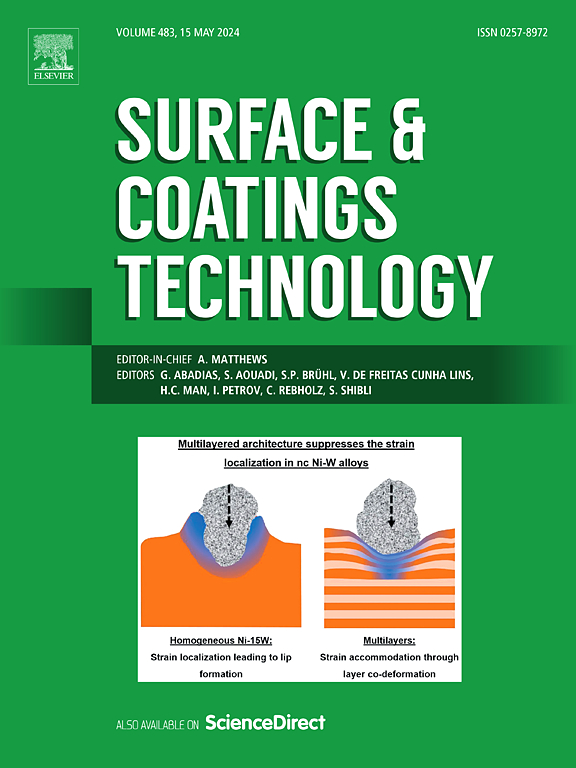318LN双相钢渗氮过程的原位XRD研究
IF 5.3
2区 材料科学
Q1 MATERIALS SCIENCE, COATINGS & FILMS
引用次数: 0
摘要
采用原位x射线衍射(XRD)研究了318LN双相不锈钢在350 ~ 500℃的渗氮过程,获得了渗氮过程中扩散和相形成的详细过程。此外,利用非原位调查的补充结果获得了一个全面的画面。原位XRD数据显示氮元素快速扩散,基底的反射被扩展的奥氏体相所取代。原位x射线衍射(XRD)和飞行时间二次离子质谱(ToF-SIMS)得到的扩散系数几乎相同,但相分辨数据显示铁素体的扩散速度略快于奥氏体基体。只有在485°C的最高温度下,才会很早就观察到CrN和FeNi相的衰变,在25分钟内开始。在450°C时,没有观察到这种衰变。此外,在450°C渗氮后的蚀刻过程中获得的原位XRD结果与双相钢衬底顶部的单一膨胀奥氏体相一致。然而,互补扫描电镜(SEM),包括能量色散x射线能谱(EDX)和电子背散射衍射(EBSD)研究表明,膨胀奥氏体和x射线无定形、高度无序的铁素体结构的混合物作为含氮相,而该第二相在XRD中完全不可见。本文章由计算机程序翻译,如有差异,请以英文原文为准。
In-situ XRD investigations during nitriding of duplex steel 318LN
Nitriding of duplex stainless steel 318LN was investigated using in-situ X-ray diffraction (XRD) to obtain details on the temporal evolution of the diffusion and the phase formation in the temperature range of 350–500 °C. Additionally, complementary results from ex-situ investigations are used obtain a comprehensive picture. In-situ XRD data show a fast nitrogen diffusion where the reflections of the underlying substrate are replaced by an expanded austenite phase. The diffusivities derived from in-situ XRD and Time-of-flight secondary ion mass spectrometry (ToF-SIMS) are nearly identical, yet the phase resolved data yield a slightly faster diffusion for ferrite than for the austenite matrix. Only for the highest temperature of 485 °C, a decay into CrN and a Fe![]() Ni phase is observed rather early, starting within 25 min. For 450 °C, no such decay has been observed.
Ni phase is observed rather early, starting within 25 min. For 450 °C, no such decay has been observed.
Furthermore, in-situ XRD results obtained during etching after nitriding at 450 °C again are consistent with a single expanded austenite phase on top of the duplex steel substrate. However, complementary scanning electron microscopy (SEM) including energy dispersive X-ray spectroscopy (EDX) and electron backscatter diffraction (EBSD) investigations point towards a mixture of expanded austenite and an X-ray amorphous, highly disordered ferritic structure as the nitrogen containing phase with this second phase being completely invisible in XRD.
求助全文
通过发布文献求助,成功后即可免费获取论文全文。
去求助
来源期刊

Surface & Coatings Technology
工程技术-材料科学:膜
CiteScore
10.00
自引率
11.10%
发文量
921
审稿时长
19 days
期刊介绍:
Surface and Coatings Technology is an international archival journal publishing scientific papers on significant developments in surface and interface engineering to modify and improve the surface properties of materials for protection in demanding contact conditions or aggressive environments, or for enhanced functional performance. Contributions range from original scientific articles concerned with fundamental and applied aspects of research or direct applications of metallic, inorganic, organic and composite coatings, to invited reviews of current technology in specific areas. Papers submitted to this journal are expected to be in line with the following aspects in processes, and properties/performance:
A. Processes: Physical and chemical vapour deposition techniques, thermal and plasma spraying, surface modification by directed energy techniques such as ion, electron and laser beams, thermo-chemical treatment, wet chemical and electrochemical processes such as plating, sol-gel coating, anodization, plasma electrolytic oxidation, etc., but excluding painting.
B. Properties/performance: friction performance, wear resistance (e.g., abrasion, erosion, fretting, etc), corrosion and oxidation resistance, thermal protection, diffusion resistance, hydrophilicity/hydrophobicity, and properties relevant to smart materials behaviour and enhanced multifunctional performance for environmental, energy and medical applications, but excluding device aspects.
 求助内容:
求助内容: 应助结果提醒方式:
应助结果提醒方式:


